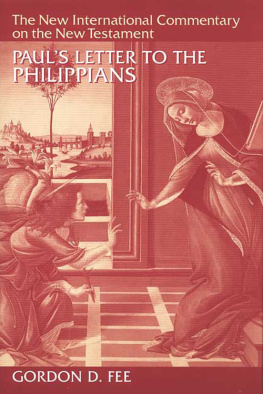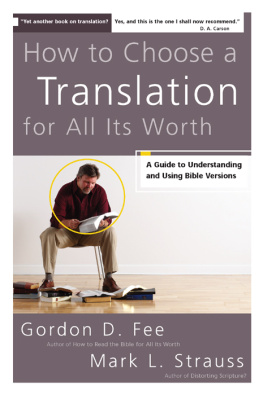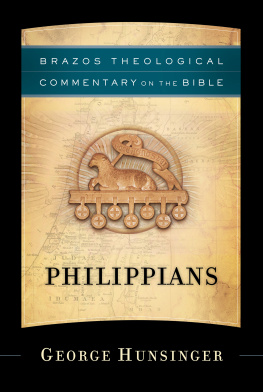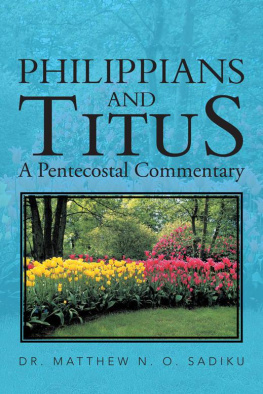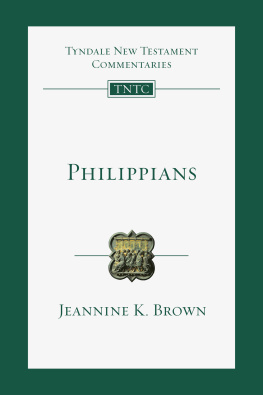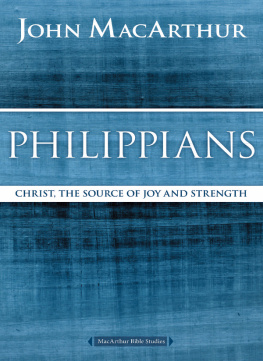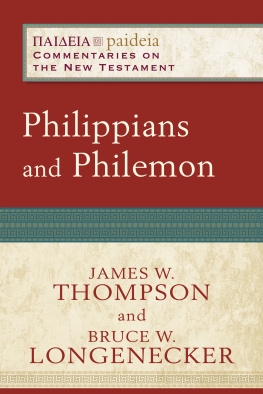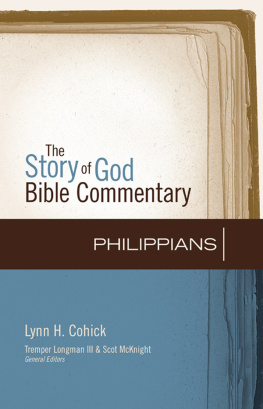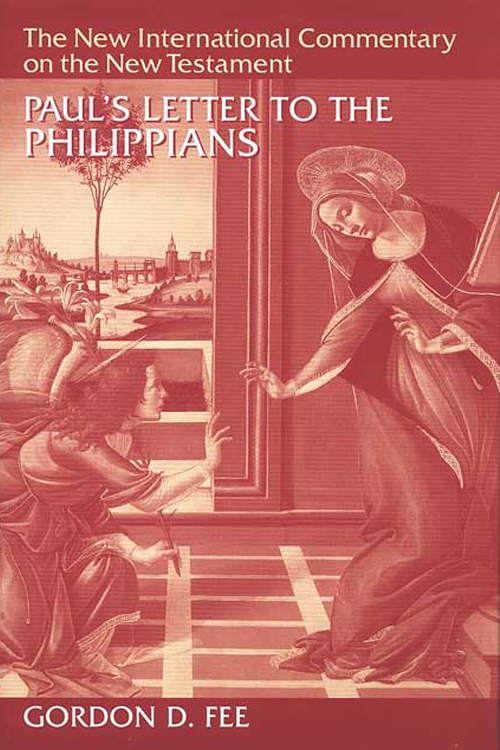
Pauls Letter to the
PHILIPPIANS
Gordon D. Fee
W ILLIAM B . E ERDMANS P UBLISHING C OMPANY
G RAND R APIDS, M ICHIGAN / C AMBRIDGE, U . K .
1995 Wm. B. Eerdmans Publishing Co.
2140 Oak Industrial Drive N.E., Grand Rapids, Michigan 49505 /
P.O. Box 163, Cambridge CB3 9PU U.K.
All rights reserved
Library of Congress Cataloging-in-Publication Data
Fee, Gordon D.
Pauls Letter to the Philippians / by Gordon D. Fee.
p. cm.(The New International commentary on the New Testament)
Includes .
eISBN 978-1-4674-2264-2
ISBN 0-8028-2511-7 (alk. paper)
1. Bible. N. T. PhilippiansCommentaries. I. Title. II. Series.
BS2705.3.G67 1995
227.6077dc20 9517640 CIP
Scripture taken from the HOLY BIBLE: NEW INTERNATIONAL VERSION. NIV. Copyright 1973, 1978, 1984 by International Bible Society. Used by permission of Zondervan Publishing House.
For Sven Soderlund
Colleague
and
Friend
CONTENTS
INDEXES
Although the author of this commentary and editor of this series are the same person, it seemed fitting in this case to have an editors as well as an authors preface. The reasons for this are three:
First, this is the first volume to appear in the under my editorship. It is also the second volume to appear under the new format and book design. Hopefully, this new design will make the series much more user friendly; it came about in fact as a response to the many complaints about the two larger volumes in this series (Morris on John and Fee on 1 Corinthians), that they will not lie open on the desk as one is trying to use them. Thus, I herewith offer my gratitude to the Eerdmans Publishing Company for undertaking the new design; in time all the former volumes will be brought into conformity.
Second, although coincidental, it has turned out that the second and third editors of the series have written the replacement volumes on Philemon and Philippians, which originally appeared in a single volume by J. J. Mller (1955). In the original series, the commentaries on Colossians (by F. F. Bruce) and Ephesians (by E. K. Simpson) also constituted a single volume. As the second editor of the series, Professor Bruce updated his Colossians commentary and wrote the replacement volumes on Ephesians and Philemon, which were then published together in one volume. That left the unusual situation of a set of commentaries having two works on Philemon. Meanwhile, the sheer volume of literature on Philippians over the past forty yearsand the many new directions that Philippians studies have takenhas called for a replacement volume on this letter as well. Since I was scheduled to write a more popular commentary on this letter (in the IVP NT commentary series), the publishers asked if I would be willing to write the Philippians volume for the as well. With the consent of the editors at InterVarsity Press, I agreed to do so.
Third, it became clear to me early on that the editor needed an editor. So in fact the true editor of this volume has been my colleague at Regent College, Sven Soderlund, who brought the experience of years of teaching the Captivity Letters to the task, as well as an uncommon devotion to detail and a keen eye for Feeisms of all kinds (including impossible sentences and various malaprops)although I resisted his efforts at times and must be held accountable for those that remain. Thus, even though the final product is my own, and for good or ill I am responsible for the points of view put forward, Sven has saved me from many an embarrassment, for which I am truly grateful. Indeed, I have learned much about the task of editing from his very careful working through my first draft. For his untiring efforts on my behalfand on behalf of all who may profit from this commentaryI offer my grateful thanks by dedicating the volume to him.
For the rationale as to the form and style of this commentary, one is invited to read carefully the Authors Preface to my volume on 1 Corinthians in this series (pp. ixxii), which I had the opportunity to spell out in greater detail in a symposium on the writing of commentaries in Theology 46 (1990) 38792.
But I do need here to reiterate some presuppositions and idiosyncrasies for the sake of the reader. First, without apology I have consciously written this commentary to help the parish minister and teacher of Scripture better understand this letter as the Word of God for a contemporary congregation. At the same time I have been very well aware of the scholar and the classroom teacher. Everything about the format and style gives evidence of this twofold audience. For the primary readership I have tried to make the exposition as uncluttered and as readable as possible. Hopefully, even those Bible students without formal training (and who are not turned off by the appearance of so many footnotes!) will find much profit by reading the text and skipping the notes altogether. For that reason, I have reserved almost all technical discussions of textual criticism, grammar, and lexicography, for the footnotes. There also one will find my indebtedness to, and (sometimes vigorous) interaction with, those who have written on Philippians before me. The notes, therefore, are full of many things; and the user is invited to read around as many of these as he or she needs to in order to keep a steady eye on the meaning of Philippians itself.
That leads me, second, to say a further word about my relationship to previous literature. As with the commentary on 1 Corinthians, I assiduously avoided reading anything on a given paragraphand tried to keep out of mind what I had read previouslyuntil I had written and rewritten my own exposition of the text, along with the various textual, grammatical, and lexical notes. I then went through the literature (basically 25 commentaries covering a broad range of time and perspective, plus all known specialized studies on the passage) in chronological order (through early 1994), after which I interacted, 103 [1991] 3942).
Third, although the writer of a commentary assumes that its users will never read the Introduction (!), here is an instance when it seems quite important that the user do soat least Part I on Philippians as a first-century letter, since the entire commentary has been written from the perspective spelled out there. On other introductory matters, I simply forewarn that there is nothing new, and that the traditional provenance (Rome) and dating (ca. 62 CE) are presupposedwith explanation but with little argumentation.
Fourth, since I think there is some usefulness in doing so, the references to Pauls letters are given in their presumed chronological order (1 and 2 Thessalonians, 1 and 2 Corinthians, Galatians, Romans, Philemon, Colossians, Ephesians, Philippians, 1 Timothy, Titus, 2 Timothy); as before I consider the Pastoral Epistles Pauline in the sense that they ultimately derive from him in the first half of the seventh decade CE (between 62 and 64).
Finally, in a day like ours, when Greek is no longer required in the majority of seminaries, and when sociological and literary concerns have far outstripped grammatical ones in exegesis, one is a little hesitant to make too many references to the Greek. Hopefully, this commentary has taken into account, not always in agreement with the secondary literature, what we can learn from the sociology of the first century and from its various literary and rhetorical devices. But let me here enter a plea for grammar, which also counts for something. To be sure, I am on the side of those who find many of my predecessorsand some contemporariesto engage in finding more meaning in grammar and words than surely Paul intended. (I wonder if he thought through his talk anymore than many of us do, especially in the writing of letters.) Over-exegeting, I call it. On the other hand, neither do I think Paul simply wrote willy-nilly; I am convinced on the contrary that the
Next page
